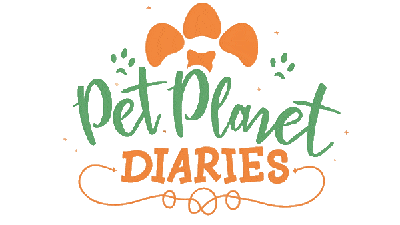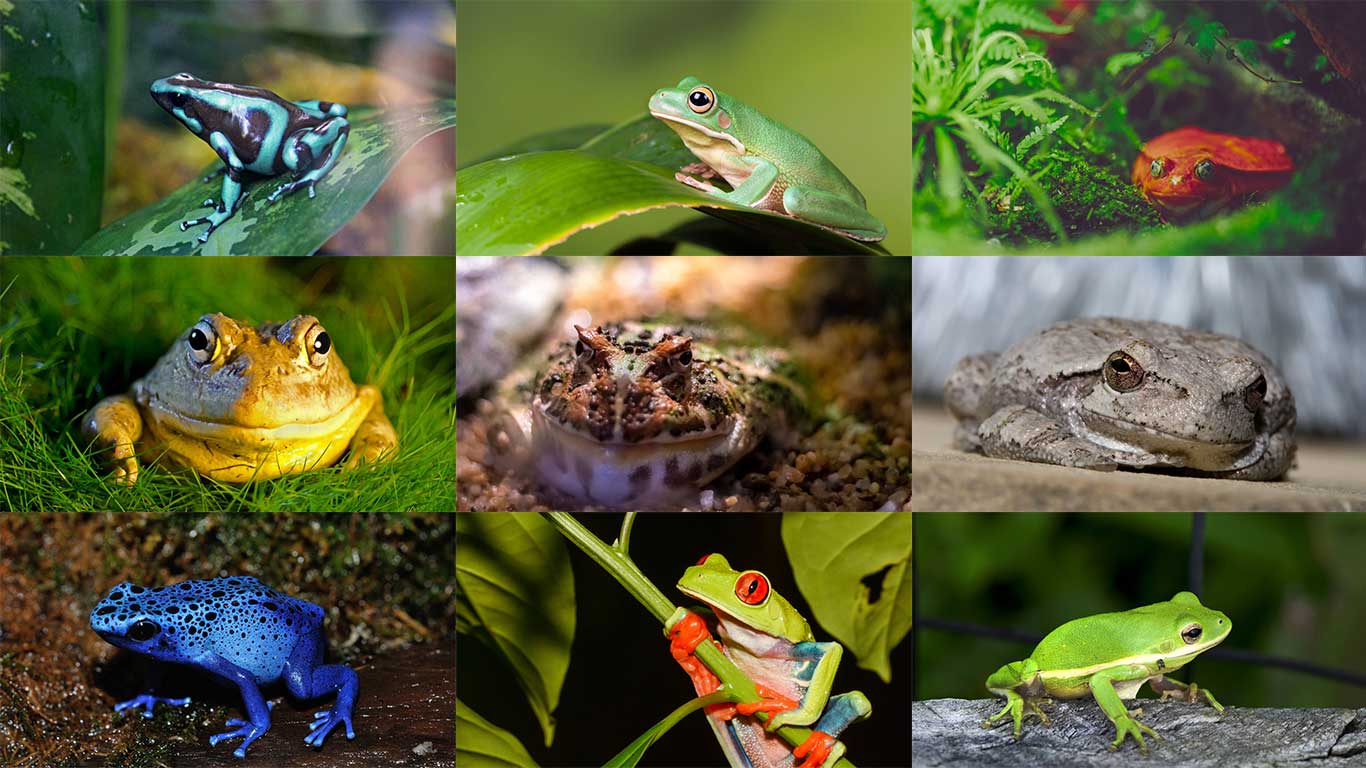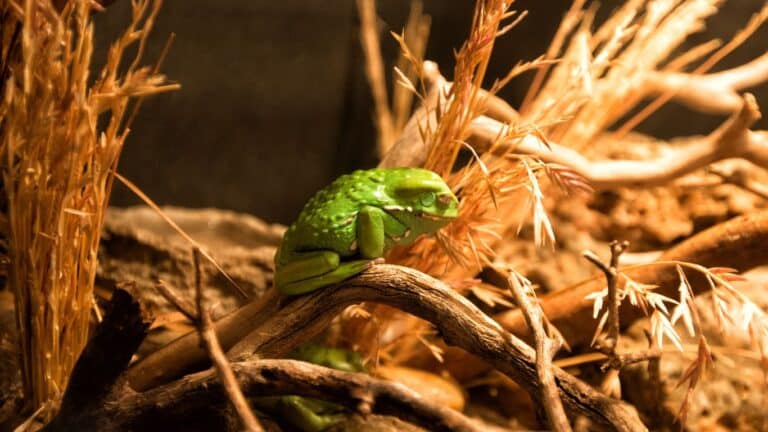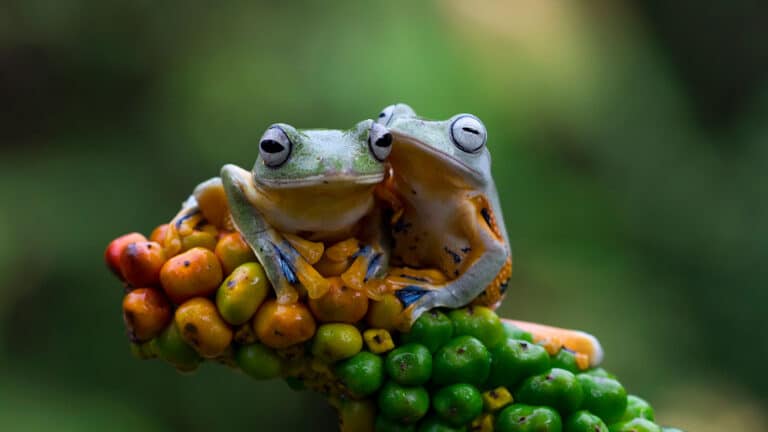If you’re looking for a pet that is low-maintenance, visually appealing, and brings a unique charm to your home, pet frogs are an excellent choice. These fascinating creatures provide easy care and endless entertainment. In this article, we will explore the top 5 best pet frogs that are perfect for beginners like you.
Froggy Favorites: Must-Remembers
Horned Frogs (Ceratophrys sp.)
Horned frogs, also known as Pacman frogs, are large ground-dwelling species that are easy to care for and have a striking appearance. They can grow up to 8 inches in length and come in a variety of color morphs. Their enclosure setup is simple, and their diet is not complicated, making them a great choice for beginner frog owners.
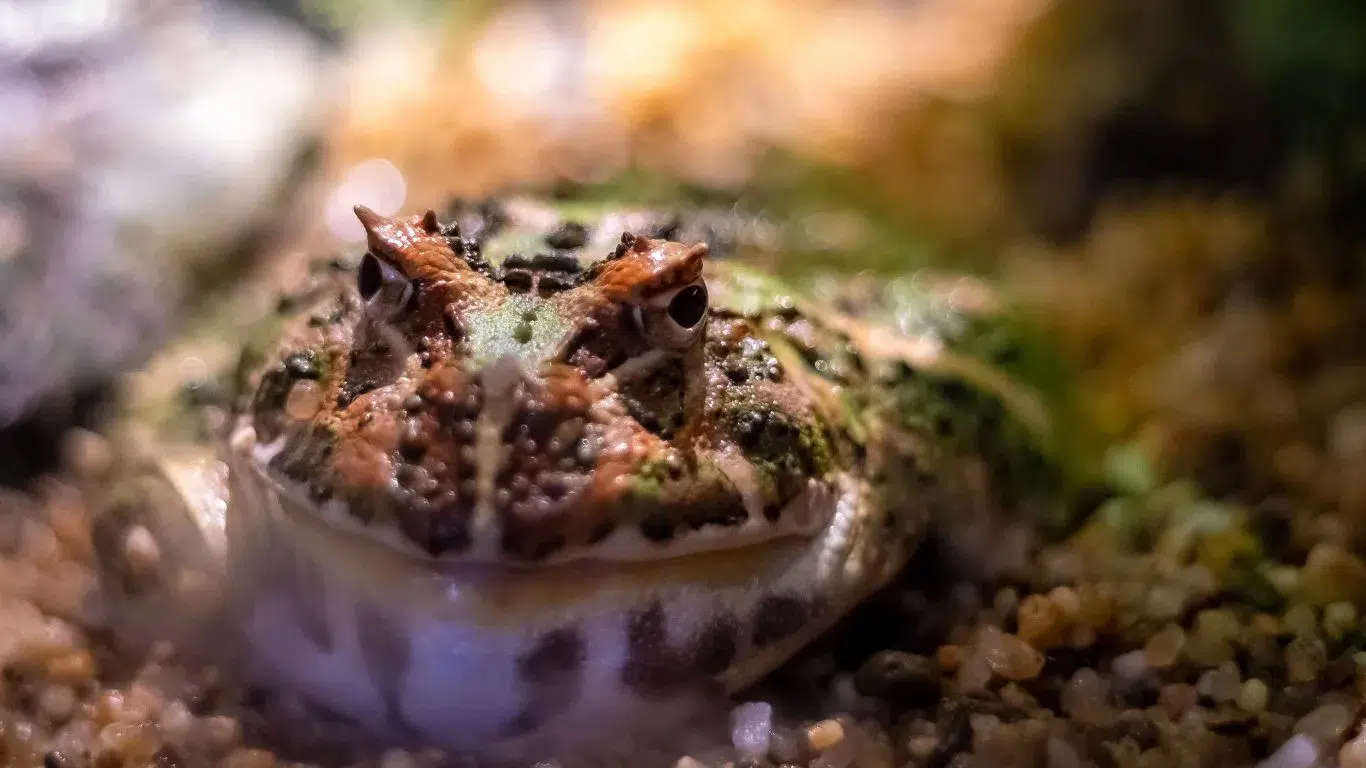
One of the most distinctive features of horned frogs is their wide mouth, which resembles the popular video game character Pac-Man. These frogs are known for their voracious appetite and will eat almost anything that fits into their mouth, including crickets, worms, and small mice. However, it’s important to provide a balanced diet to ensure their nutritional needs are met.
The enclosure for horned frogs should mimic their natural habitat, with a moist and humid environment. Adding live plants and hiding spots will create a comfortable and stress-free space for these frogs. It’s also crucial to maintain the proper temperature and humidity levels to promote their health and well-being.
When handling horned frogs, it’s important to be cautious as they have a strong bite and can be aggressive if they feel threatened. It’s best to observe and appreciate these frogs from a safe distance rather than attempting to handle them.
“Horned frogs, also known as Pacman frogs, are fascinating creatures that make captivating additions to any frog lover’s collection. Their unique appearance and relatively low care requirements make them a popular choice among pet owners.” – Frog Enthusiast
– Frog Enthusiast
If you are looking for a visually striking and low-maintenance one of the best pet frogs, consider adding a horned frog to your collection. Their distinctive appearance and easy care make them an excellent choice for beginners.
Gray Tree Frogs (Hyla chrysoscelis)
If you’re a beginner looking for an active and visually appealing pet frog, the Gray Tree Frog is one of the best pet frogs. These small tree-dwelling frogs are commonly found in North America and are known for their quick movements and impressive climbing abilities.
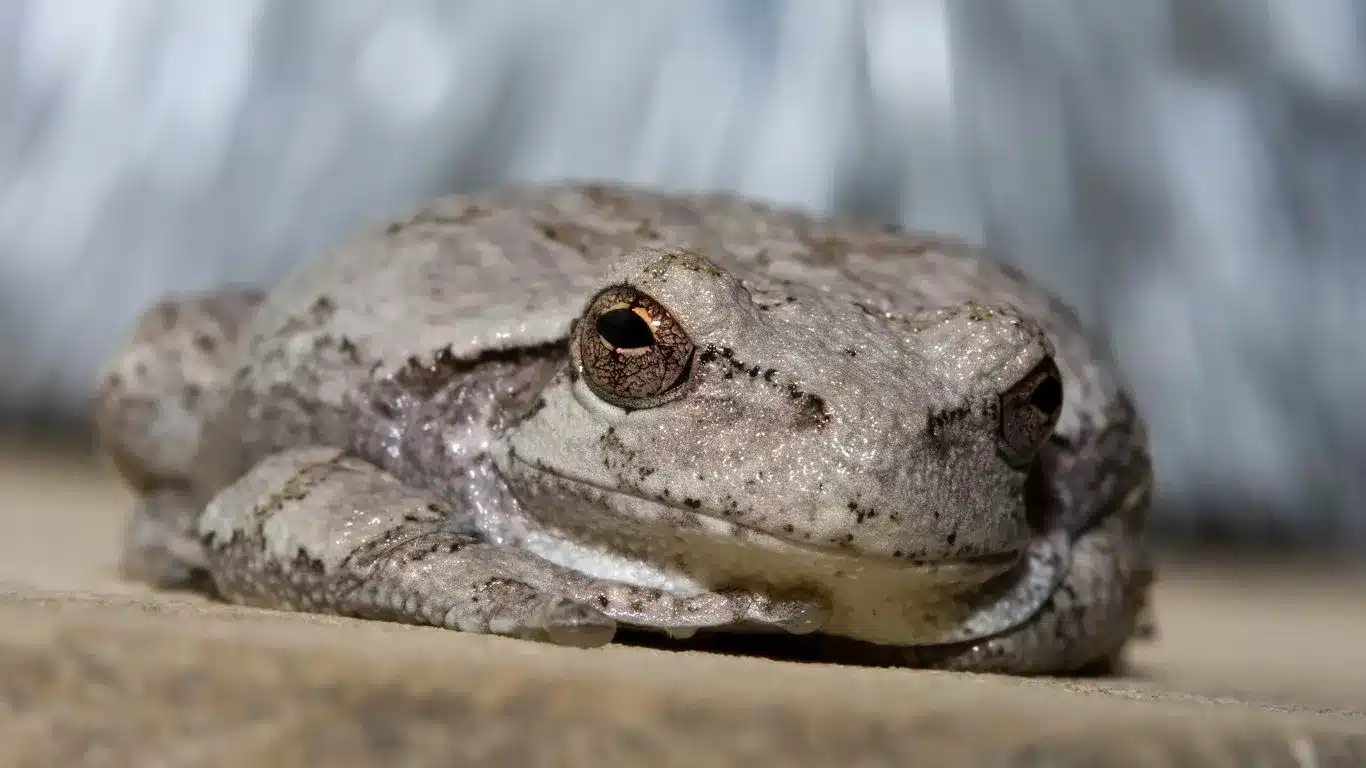
Gray Tree Frogs are relatively easy to care for and can be housed in a small enclosure, making them a convenient option for those with limited space.
These arboreal frogs have unique characteristics that make them fascinating companions. Their intricate color patterns and ability to change shades between gray and green allow them to blend seamlessly into their natural environments.
Here are some key features of Gray Tree Frogs:
- Size: Adults typically reach a length of 1.5 to 2.38 inches (3.8 to 6 cm).
- Appearance: They have a distinctively shaped body with pads on their toes for climbing trees.
- Behavior: Gray Tree Frogs are highly active and enjoy exploring their surroundings. They are known for their loud and distinctive calls during the breeding season.
- Environment: These frogs naturally inhabit wooded areas and are best kept in a setup that mimics their natural environment. An enclosure with branches, foliage, and damp substrate will ensure their well-being.
- Diet: Gray Tree Frogs primarily feed on small insects and invertebrates, making them relatively inexpensive to feed.
Recommended Enclosure Setup for Gray Tree Frogs
To create a suitable habitat for your Gray Tree Frog, consider the following enclosure setup:
| Enclosure Type | Size |
|---|---|
| Glass Terrarium | At least a 10-gallon tank |
| Substrate | Damp soil, moss, or coconut fiber |
| Branches and Foliage | Provide plenty of vertical elements for climbing |
| Humidity | Maintain a humidity level of 50-70% with regular misting |
| Temperature | Keep the enclosure between 68-75°F (20-24°C) |
Remember to include a shallow water dish for drinking and soaking, as well as hiding spots to provide security for your Gray Tree Frog.
Containing an active and visually appealing pet like the Gray Tree Frog can be one of the best pet frogs. These arboreal frogs are low-maintenance and captivating to observe. Ensure you provide the ideal environment to encourage their natural behaviors and create a comfortable space for their well-being.
Dart Frogs (Dendrobates sp.)
Dart frogs, also known as poison arrow frogs, are small terrestrial frogs known for their vibrant colors. These visually stunning creatures come in a variety of shades and patterns, adding a pop of color to any collection of pet frogs. Dart frogs are a popular choice for frog enthusiasts and make excellent pets.
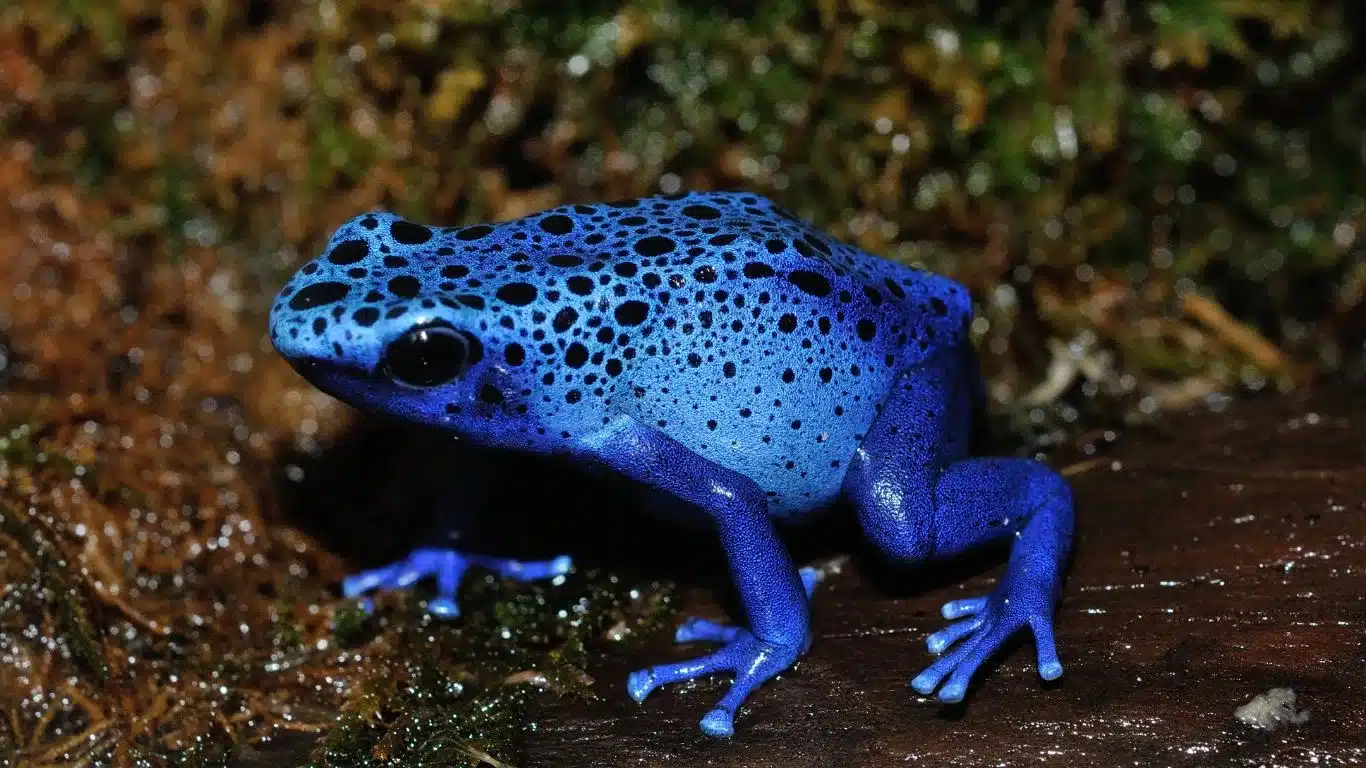
If you’re considering getting a pet dart frog, it’s important to create the right environment for them to thrive. Dart frogs require a live enclosure that mimics their natural habitat, such as a paludarium or bioactive terrarium. These setups include plants, water features, and hiding spots to meet their behavioral and environmental needs.
Dart frogs are not only beautiful but also intriguing creatures. These frogs secrete toxic substances through their skin, which serves as a defense mechanism against predators in the wild. However, in captivity, they pose no threat to humans. With proper care and handling, pet dart frogs can lead happy and healthy lives.
When it comes to feeding, dart frogs have specific dietary requirements. They primarily consume small invertebrates such as fruit flies, springtails, and pinhead crickets. Providing a varied diet is key to maintaining their health and longevity.
| Characteristic | Description |
|---|---|
| Size | Small, typically ranging from 0.5 to 2 inches in length |
| Color | A wide range of vibrant colors and patterns |
| Native Habitat | Tropical rainforests in Central and South America |
| Enclosure Setup | Live enclosure with plants, water, and hiding spots |
| Diet | Small invertebrates such as fruit flies and pinhead crickets |
| Lifespan | Around 5 to 10 years in captivity |
If you’re interested in adding a dart frog to your family, be sure to research and understand their specific care requirements. This one of the best pet frogs can bring beauty and intrigue to your home, making them a wonderful choice for any frog enthusiast.
Red Eye Tree Frog (Agalychnis callidryas)
The red eye tree frog, also known as Agalychnis callidryas, is an iconic species that captivates with its vibrant colors and striking appearance. Native to the rainforests of Central America, these tree frogs are highly sought after by pet enthusiasts for their unique characteristics and charm.
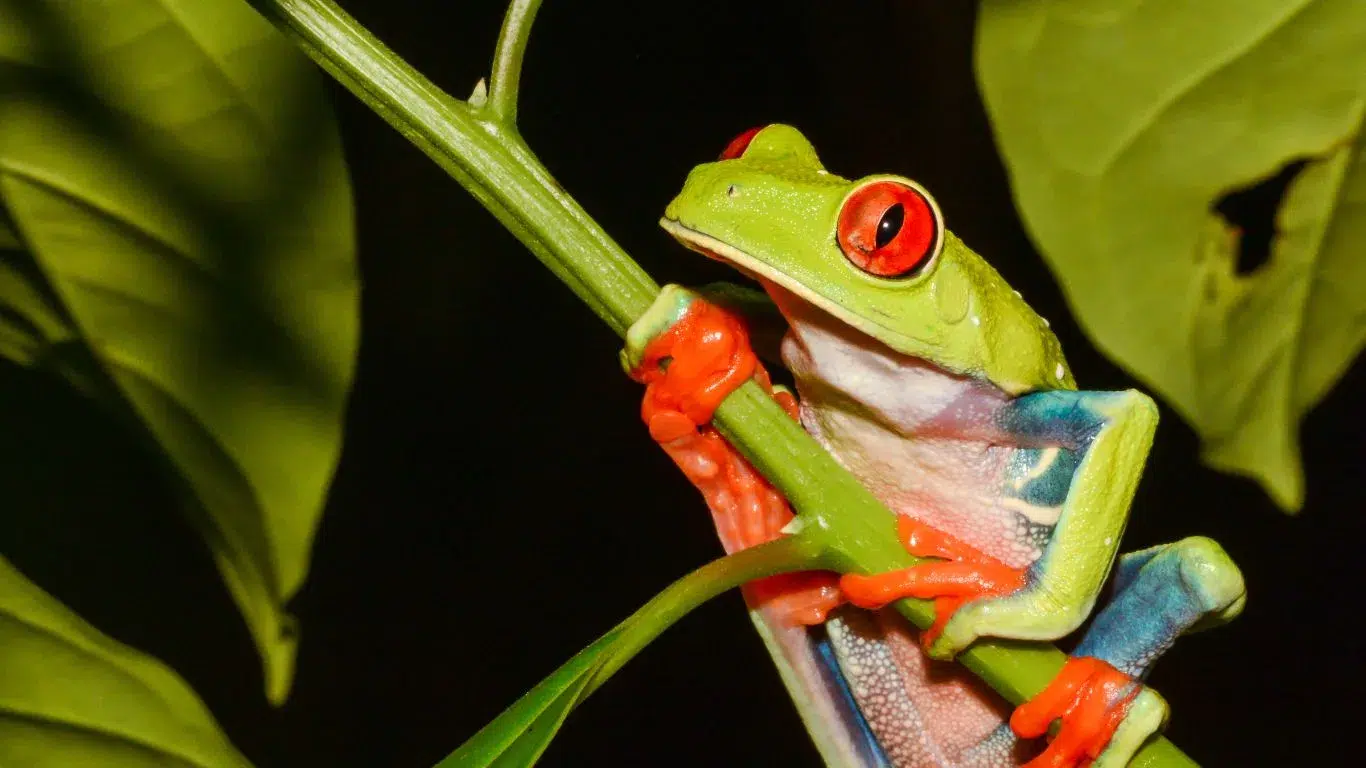
To provide the best care for your pet red eye tree frog, it is important to create an enclosure that mimics their natural habitat. These frogs require a larger setup with ample humidity, warmth, and UVB lighting. A spacious and well-ventilated terrarium or vivarium is essential to ensure their comfort and well-being.
Red eye tree frogs are somewhat sensitive creatures, and maintaining the right environmental conditions is crucial. They thrive in temperatures ranging from 72°F to 82°F (22°C to 28°C) with a humidity level of around 50% to 80%. Adequate ventilation and air circulation are important to prevent respiratory issues.
When designing their enclosure, provide a mix of climbing branches and sturdy plants to simulate their natural arboreal environment. Live plants such as bromeliads, pothos, and Philodendron can help maintain humidity and provide hiding spots for your frog.
A shallow water dish or a small pond feature within the enclosure is recommended, as red eye tree frogs enjoy soaking and staying hydrated.
Feeding red eye tree frogs is an enjoyable experience as they display their vibrant colors during mealtime. They primarily feed on small insects like crickets, fruit flies, and butterworms. Providing a varied diet and dusting the prey with a calcium supplement will ensure the necessary nutrition for your pet.
Red eye tree frogs have captivating behaviors that add to their charm. They are known for their unique ability to light up with vibrant colors during mealtime or when sprayed with water. These fascinating displays are a delight to observe and make them a truly captivating pet.
Care Summary for Red Eye Tree Frogs:
- Provide a larger enclosure with humidity, warmth, and UVB lighting.
- Maintain temperatures between 72°F and 82°F (22°C to 28°C) with a humidity level of 50% to 80%.
- Set up a well-ventilated terrarium or vivarium with climbing branches and live plants.
- Feed a varied diet of small insects and supplement with calcium.
- Enjoy their vibrant colors and unique behaviors during mealtime and when sprayed with water.
With the right care and attention, the red eye tree frog can make a stunning addition to your pet collection. Their dazzling appearance and captivating behaviors will undoubtedly bring joy and wonder to any frog enthusiast.
Whites Tree Frogs (Litoria caerulea)
Whites tree frogs, also known as Litoria caerulea, are the largest arboreal frogs on this list. These charming creatures are well-loved for their lazy behavior and ease of handling, making them excellent choices for pet owners seeking a low-maintenance companion.
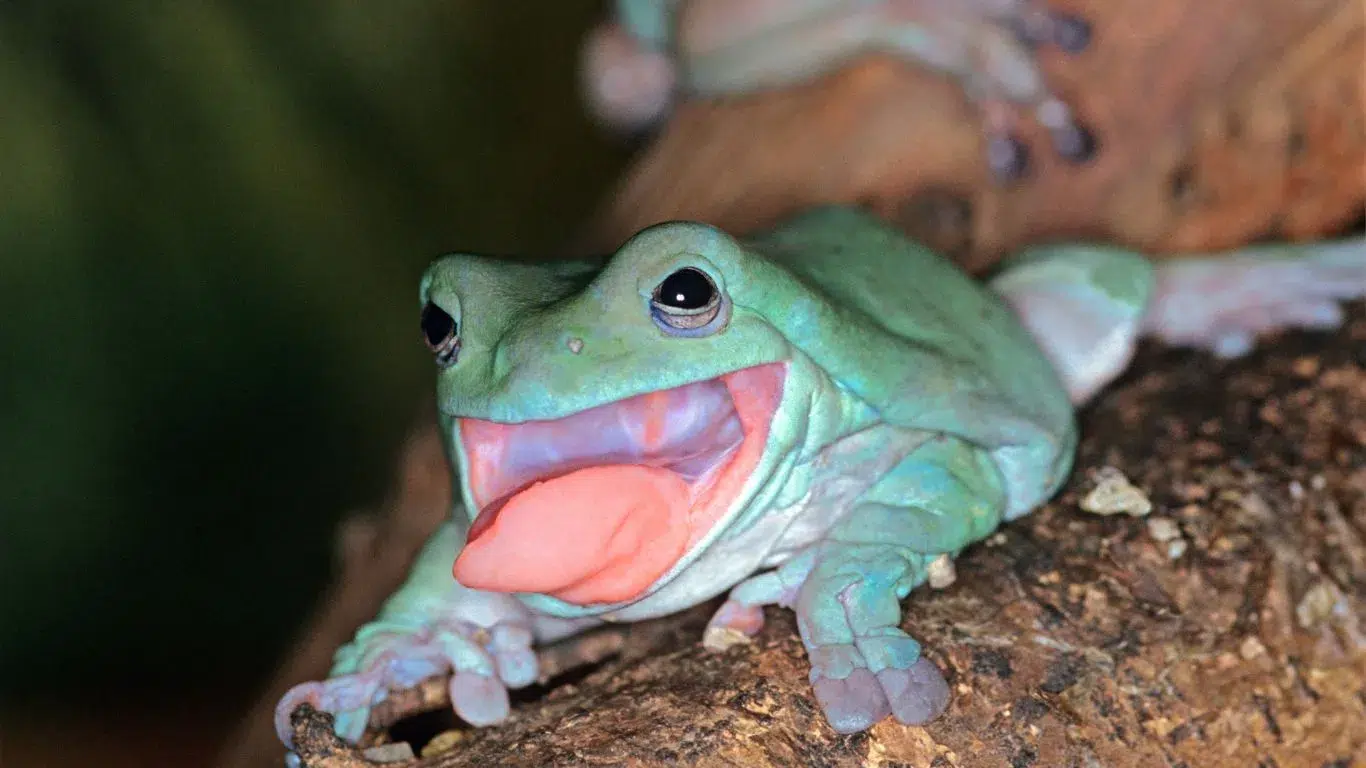
Popular among families and readily available in pet stores, whites tree frogs offer a delightful addition to any household. While their size may appear intimidating to some, their calm demeanor and fondness for human interaction make them ideal for beginners and frog enthusiasts alike.
To provide the best care for your pet whites tree frogs, it is crucial to create a suitable enclosure with the proper setup. These arboreal frogs require an environment that mimics their natural habitat, including ample space for climbing and hiding spots for added security.
White tree frogs are known for their stunning appearance, with vibrant green skin and endearing eyes. Their large size and distinctive features make for an impressive visual display in any frog collection. Captivating to observe, these frogs possess a unique charm that is sure to captivate both young and old.
Whether you are a seasoned frog enthusiast or a beginner looking to embark on an exciting pet-owning journey, pet whites tree frog is one of the best pet frogs. Their arboreal nature and friendly disposition make them a popular choice among reptile and amphibian lovers.
Get ready to embark on an adventure with your new pet whites tree frog, as you experience the unique joys of owning one of the largest arboreal frogs.
You can reference the table below for a quick overview of the key features of whites tree frogs:
| Species | Litoria caerulea |
|---|---|
| Size | 4-5 inches |
| Behavior | Lazy and calm |
| Enclosure Size | 20-gallon tank or larger |
| Temperature | 75-85°F (24-29°C) |
| Humidity | 50-70% |
| Diet | Insects and small vertebrates |
| Lifespan | 10-15 years |
White Lipped Tree Frog
The white lipped tree frog is an exotic pet frog that originates from Australia and New Guinea. Known for its distinctive white stripe and impressive size, it is the largest tree frog species. These gentle creatures are ideal for beginners, as they are easy to handle and care for.
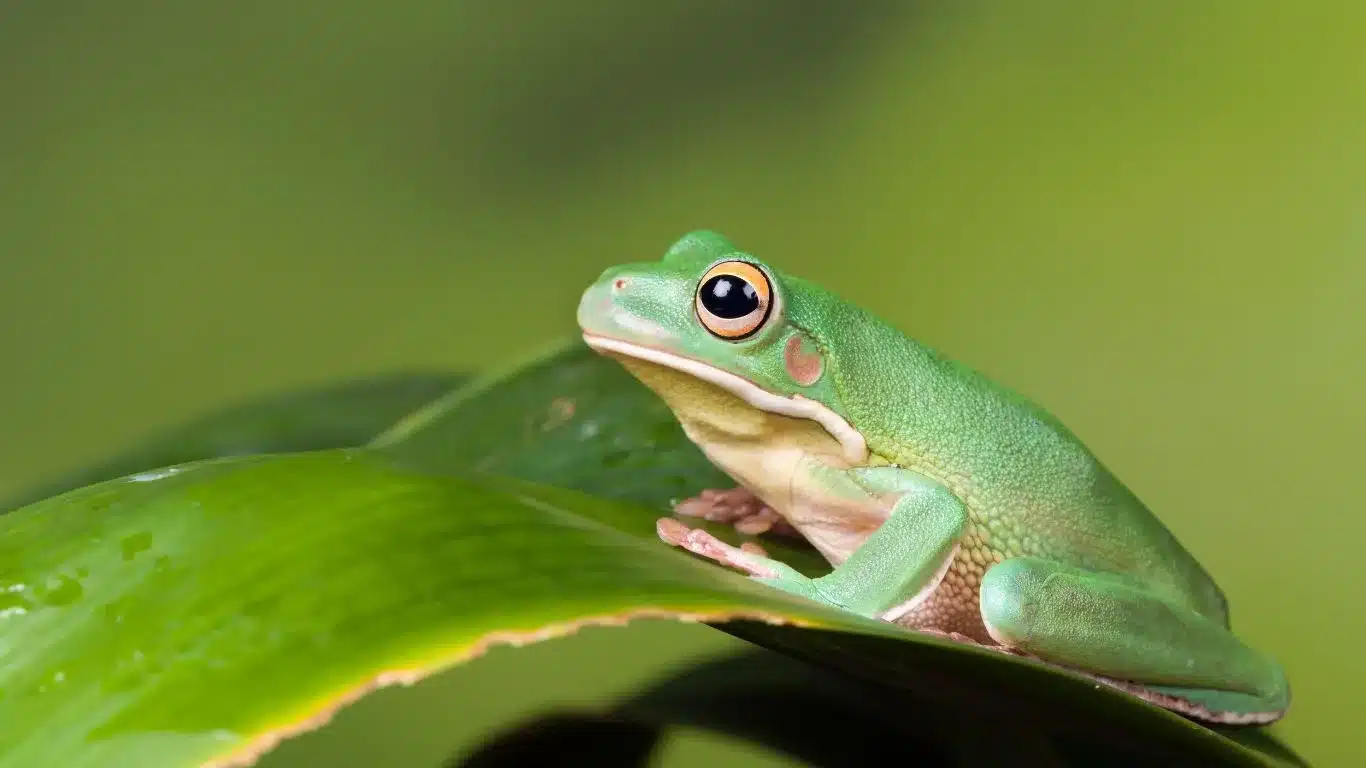
To ensure the well-being of your white lipped tree frog, it is essential to provide them with a spacious enclosure that mimics their natural habitat. Create a comfortable environment with plenty of climbing opportunities, hiding spots, and moisture. A well-designed enclosure will help your pet thrive.
Here are some key care tips:
- Temperature and humidity: Maintain a temperature range of 75-85°F and a humidity level of 60-80%. Use a hygrometer to monitor humidity.
- Lighting: White lipped tree frogs require UVB lighting to support their overall health and vitamin D synthesis. Ensure they receive 10-12 hours of light a day.
- Diet: Feed your white lipped tree frog a varied diet of gut-loaded insects, such as crickets, mealworms, and Dubai roaches. Dust their food with a calcium supplement.
- Handling: These frogs have a calm temperament and can be gently handled. However, limit handling to reduce stress and always wash your hands before and after interaction.
With proper care and attention, your white lipped tree frog can live a long and happy life. Enjoy observing their unique behaviors and fascinating interactions with their environment.
| Appearance | Size | Coloration |
|---|---|---|
| The white lipped tree frog has a slender body with smooth skin and a distinctive white stripe that runs along its upper lip. | Adult white lipped tree frogs can reach a size of up to 4-5 inches in length. | They have a range of color variations, including shades of green, brown, and gray. |
“The white lipped tree frog is an captivating species that offers a unique experience for frog enthusiasts. Their gentle nature and striking appearance make them a wonderful addition to any frog lover’s collection.” – John Murphy, Herpetologist
– John Murphy, Herpetologist
American Green Tree Frog
The American green tree frog is a wonderful choice for those looking for a low-maintenance pet frog. Native to the central and southeastern United States, these charming frogs are known for their bright green coloration and lively nocturnal behavior. Their vibrant presence adds excitement and beauty to any terrarium.
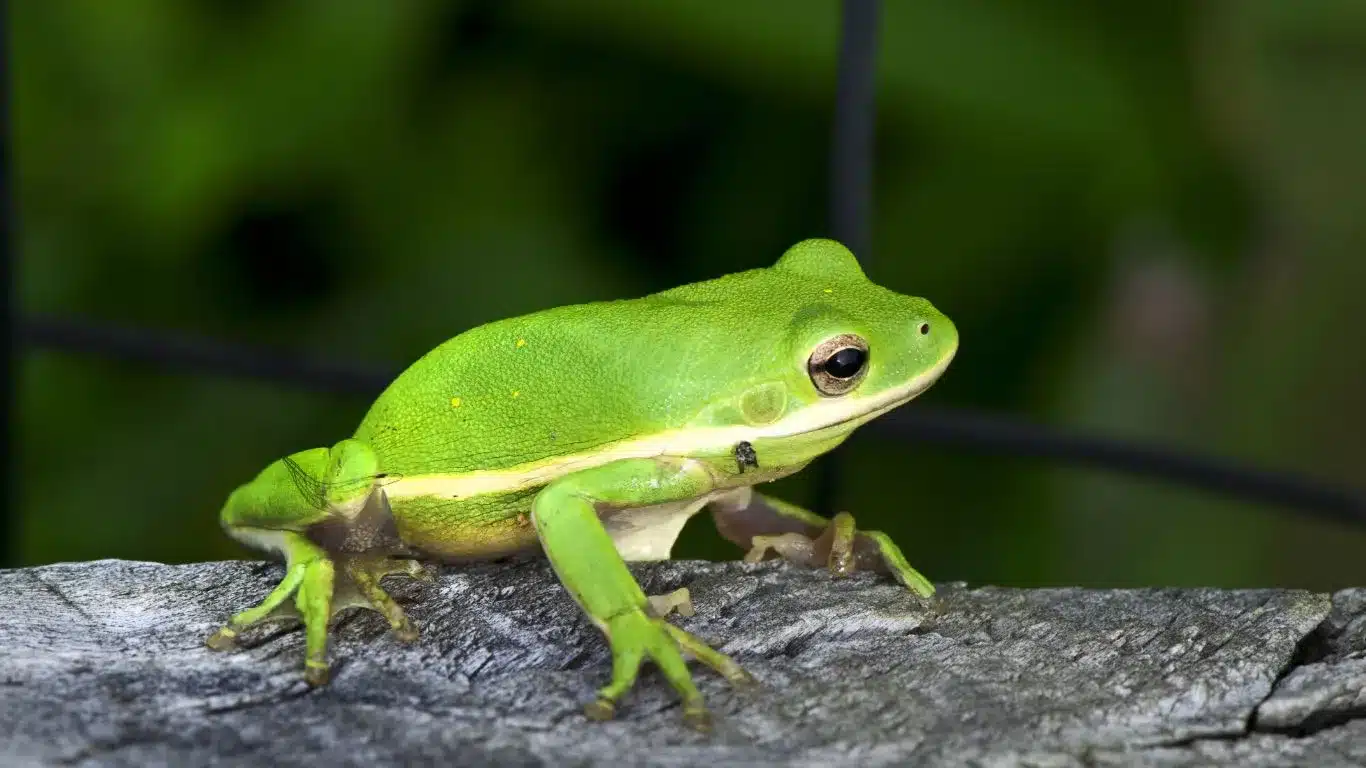
This small frog species is perfect for individuals who want a pet that doesn’t require constant attention. American green tree frogs are relatively easy to care for and can adapt to various environments. With the right setup, they can thrive and bring joy to their owners for many years to come.
These frogs have a delightful habit of climbing and perching on plants or branches, making them a pleasure to observe. Their agile movements and ability to camouflage among foliage add a touch of natural beauty to their enclosures.
When it comes to feeding, American green tree frogs are not picky eaters. They consume a diet consisting mainly of small insects such as crickets and flies, making it easy to provide them with meals.
“The American green tree frog is a great choice for individuals who want an easy-care pet that adds color and liveliness to their home.”
In brief, if you’re looking for a hassle-free and visually appealing pet frog, the American green tree frog is one of the best pet frogs. Its bright green color, active behavior, and minimal care requirements make it a fantastic addition to any terrarium. Whether you’re a seasoned frog enthusiast or a beginner looking for an easy-care pet, the American green tree frog will not disappoint.
Green & Black Dart Frog
The green & black dart frog, also known as the blue poison dart frog, is a stunning and compact pet frog. It comes in a range of colors and is native to Central and South America. These frogs require a live enclosure with plants and a small body of water. Their active behavior and vibrant colors make them a great choice for enthusiasts.
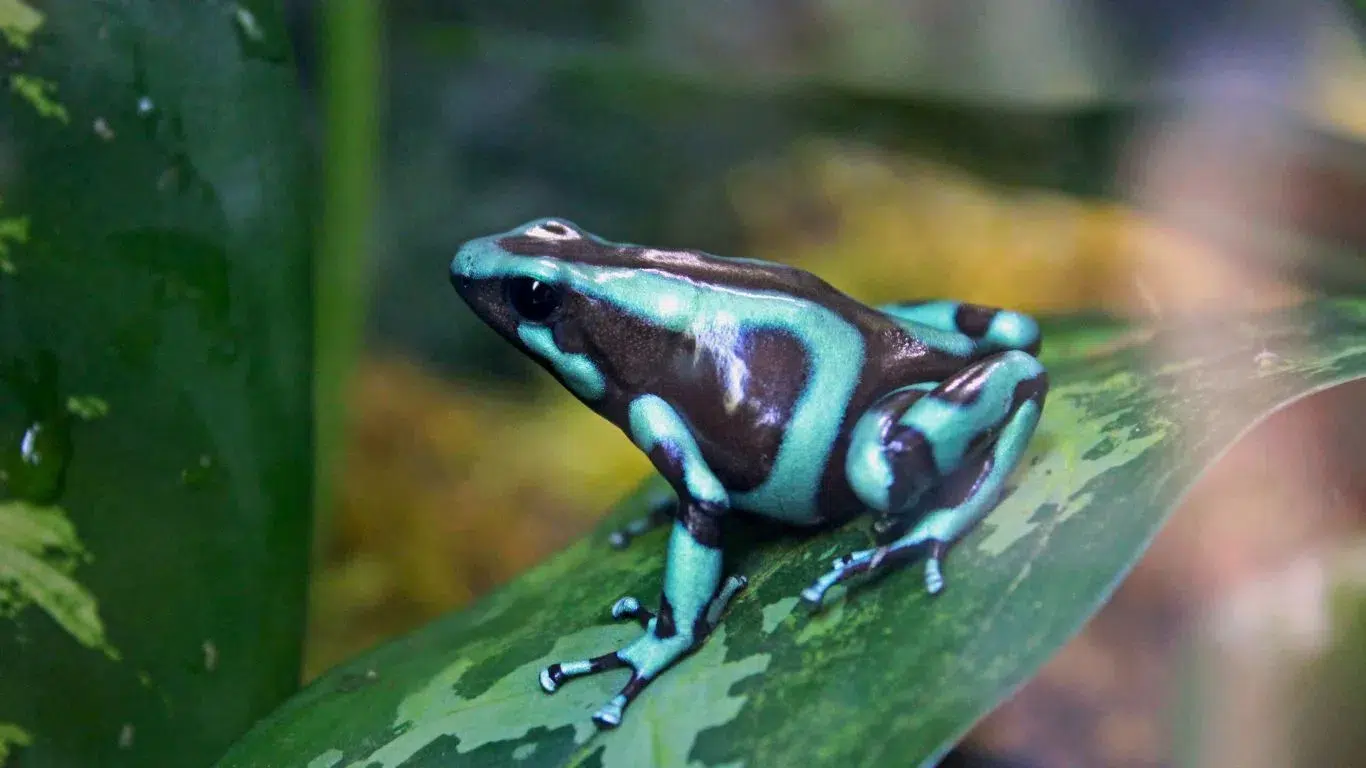
These exotic pet frogs are captivating due to their striking appearance and unique characteristics. They have a compact size, typically ranging from 1 to 2 inches, which allows for easy accommodation in a suitable enclosure.
One notable feature of the green & black dart frog is its vibrant coloration. This species exhibits variations of green and black patterns, adding a mesmerizing visual element to any enclosure. The bright hues of their skin serve as a warning to potential predators, as they secrete toxins that can be harmful.
Creating a live enclosure that mimics the natural habitat of the green & black dart frog is essential for their overall well-being. These frogs thrive in a tropical environment with high humidity levels and access to fresh water. Including a variety of plants and hiding spots in the enclosure will enable the frogs to feel secure and exhibit their natural behaviors.
Caring for Green & Black Dart Frogs: Tips and Recommendations
- Provide a terrarium with a secure lid to prevent escapes, as these frogs are excellent jumpers.
- Maintain high humidity levels (around 80%) by misting the enclosure regularly.
- Use a substrate that retains moisture well, such as coconut fiber or moss.
- Ensure the enclosure is well-ventilated to prevent the buildup of excess moisture.
- Include live plants, such as bromeliads and ferns, to create a naturalistic environment and provide hiding spots.
- Place a shallow dish of clean, dechlorinated water in the enclosure for the frogs to soak and hydrate.
- Feed the green & black dart frogs a varied diet of small insects, such as fruit flies, pinhead crickets, and springtails.
- Monitor the temperature in the enclosure to maintain a range of 72°F to 80°F (22°C to 27°C).
- Observe the frogs regularly to ensure they are healthy and displaying normal behaviors.
“The green & black dart frog is a captivating addition to any amphibian enthusiast’s collection. Their vibrant colors and active behavior make them an attractive choice for those looking to keep exotic pet frogs.” – Dr. Sarah Johnson, Herpetologist
– Dr. Sarah Johnson, Herpetologist
African Bullfrog
The African bullfrog is a fascinating and unique pet frog that is sure to capture your attention. Known for its impressive size and interesting behaviors, the African bullfrog is a popular choice among frog enthusiasts.
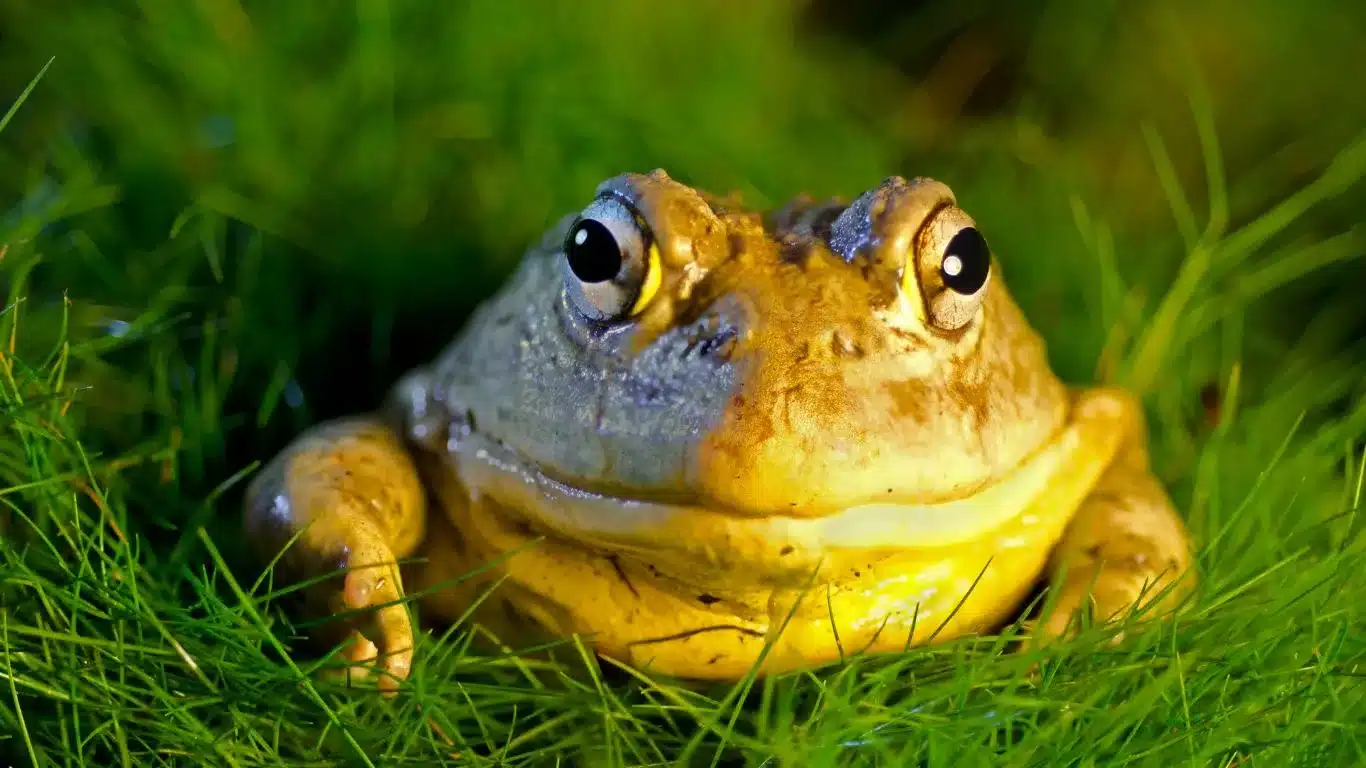
This low-maintenance frog is perfect for beginners, as it requires minimal care and attention. With the right setup, you can easily provide a comfortable and suitable habitat for your pet African bullfrog.
One of the most intriguing characteristics of the African bullfrog is its burrowing nature. These frogs love to dig and create intricate tunnels in their enclosure. Creating a substrate that is suitable for burrowing is essential for their well-being and enrichment.
Another notable trait of the African bullfrog is its tolerance for handling. While some frogs may be more sensitive or skittish, the African bullfrog tends to be more relaxed and adaptable. This allows for more opportunities to interact with your pet and observe its behaviors up close.
Benefits of Owning an African Bullfrog
- Impressive size: The African bullfrog can grow up to 10 inches in length, making it a visually striking addition to your pet collection.
- Low maintenance: These frogs have simple care requirements, making them ideal for busy or first-time frog owners.
- Unique behaviors: From their burrowing habits to their tolerance for handling, African bullfrogs offer a captivating and interactive experience.
If you’re considering a pet frog that is both fascinating and easy to care for, the African bullfrog is one of the best pet frogs. With its impressive size and unique behaviors, it is sure to be a standout addition to your home.
| Characteristic | Description |
|---|---|
| Size | Up to 10 inches in length |
| Lifespan | Average of 15 years |
| Diet | Insectivorous – primarily feeds on insects and small vertebrates |
| Enclosure Size | At least a 20-gallon tank for juveniles, larger for adults |
| Temperature | 75°F – 85°F (24°C – 29°C) |
| Humidity | 60% – 70% |
Crowned Tree Frog
The crowned tree frog is a visually striking and easy-going pet frog. Its crown-like spines on the back of its head give it a royal appearance. These frogs have a calm temperament and can be handled with care. They are adaptable and low-maintenance, making them a great choice for beginners.
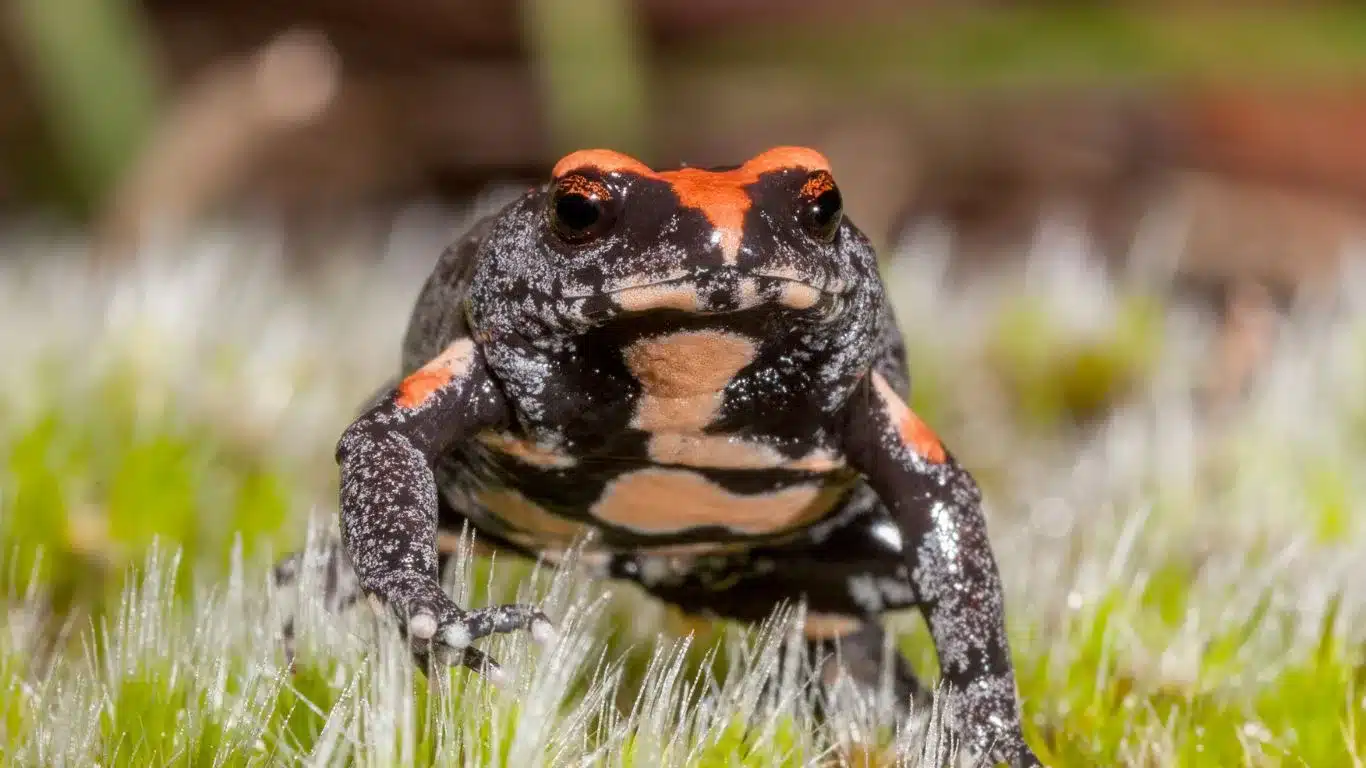
If you’re looking for a unique pet frog that will capture your attention with its regal appearance, the crowned tree frog is an excellent choice. With its distinct crown-like spines and calm demeanor, this frog will add a touch of royalty to your home. Whether you’re a seasoned frog enthusiast or a first-time reptile owner, the crowned tree frog’s low-maintenance nature makes it an ideal pet for beginners.
The crowned tree frog is a true gem among pet frogs, standing out with its crown-like features. Its striking appearance, combined with its easy-going nature, makes it a captivating and manageable addition to any frog lover’s collection.
Unlike some other pet frogs, the crowned tree frog doesn’t require elaborate setups or specialized care. A suitable enclosure with appropriate temperature and humidity levels, along with a diet of live insects, will keep this frog happy and healthy. This means less time worrying about complicated husbandry and more time enjoying the presence of your unique pet.
Another advantage that sets the crowned tree frog apart is its adaptability. This frog can thrive in different environments, making it easier for pet owners to create a suitable habitat. Whether you choose to create a bioactive vivarium or a simpler setup, the crowned tree frog will adjust well, giving you the freedom to cater to your own preferences and resources.
So, if you’re searching for a visually stunning and low-maintenance pet frog that will bring a touch of royalty to your life, the crowned tree frog one of the best pet frogs. Its regal appearance, calm temperament, and adaptable nature make it an excellent choice for both experienced enthusiasts and those new to the world of frog keeping.
Tomato Frog
The tomato frog is a small and hardy pet frog that originates from northern Madagascar. With its vibrant colors and unique behaviors, such as burrowing into the substrate, the tomato frog is a fascinating addition to any frog enthusiast’s collection.
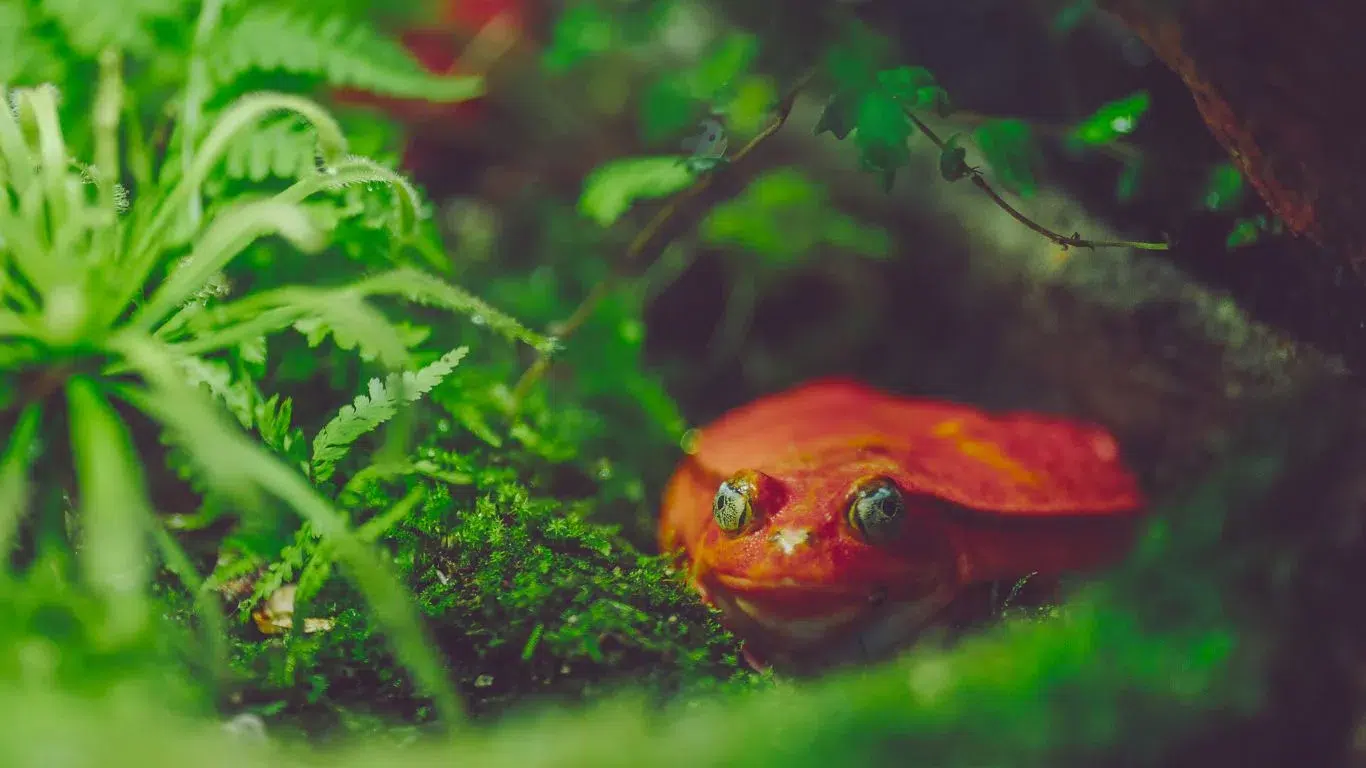
These frogs are particularly well-suited for beginner owners due to their adaptability and low-maintenance requirements. They have a reputation for being hardy and can survive in a variety of environmental conditions. This makes them an ideal choice for those new to frog ownership.
With proper care and attention, a pet tomato frog can live for up to 10 years. It is important to provide them with a suitable enclosure that mimics their natural habitat, including a secure and moist substrate. Additionally, offering a balanced diet consisting of live insects and occasional small vertebrates is crucial for their well-being.
Join the Pet Planet Diaries
Sign up for our newsletter to get the latest tips, stories, and exclusive insights into the wonderful world of pets.
Pet Tomato Frogs: Hardy and Adaptable
If you’re looking for a pet frog that is both visually striking and easy to care for, the tomato frog one of the best pet frogs to choose. These frogs, characterized by their bright red or orange coloration, are native to the forests and swamps of Madagascar.
Tomato frogs are known for their unique burrowing behavior, which allows them to hide and protect themselves from predators. They spend a significant amount of time underground, emerging primarily at night to feed and explore their surroundings.
One of the greatest advantages of owning a tomato frog is their hardiness and adaptability. They are able to tolerate a wide range of temperatures and humidity levels, making them suitable for a variety of living conditions. This makes them a great option for both experienced and novice frog keepers.
FAQ
What are the best pet frogs to have?
The top 5 best pet frogs for easy care and fun are horned frogs, gray tree frogs, dart frogs, red eye tree frogs, and whites tree frogs.
What are horned frogs?
Horned frogs, also known as Pacman frogs, are large ground-dwelling frogs that are easy to care for and visually striking.
Are gray tree frogs good pets?
Yes, gray tree frogs are small tree-dwelling frogs that are easy to care for and provide visual appeal with their quick movements and climbing abilities.
What are dart frogs?
Dart frogs, also known as poison arrow frogs, are small terrestrial frogs that come in a variety of colors and thrive in live enclosures with plants and water.
What is unique about red eye tree frogs?
Red eye tree frogs are known for their vibrant colors and require a larger enclosure with specific environmental conditions to thrive.
Why are whites tree frogs popular?
Whites tree frogs are the largest arboreal frogs and are popular for their lazy behavior and ease of handling.
What is the white lipped tree frog?
The white lipped tree frog is an exotic pet frog that has a distinctive white stripe and is the largest tree frog species.
Are American green tree frogs low-maintenance?
Yes, American green tree frogs are small and low-maintenance pets that are perfect for those looking for a pet that doesn’t require much attention.
What makes green & black dart frogs a great choice?
Green & black dart frogs are stunning and compact pet frogs that come in a range of colors and require a live enclosure with plants and water.
Why are African bullfrogs unique?
African bullfrogs are large and unique pet frogs known for their impressive size, interesting behaviors, and ease of care.
What makes crowned tree frogs a great pet?
Crowned tree frogs are visually striking and easy-going pets with a crown-like spines on the back of their heads.
Are tomato frogs hardy pets?
Yes, tomato frogs are small and hardy pets native to northern Madagascar, known for their bright colors and unique behaviors.
